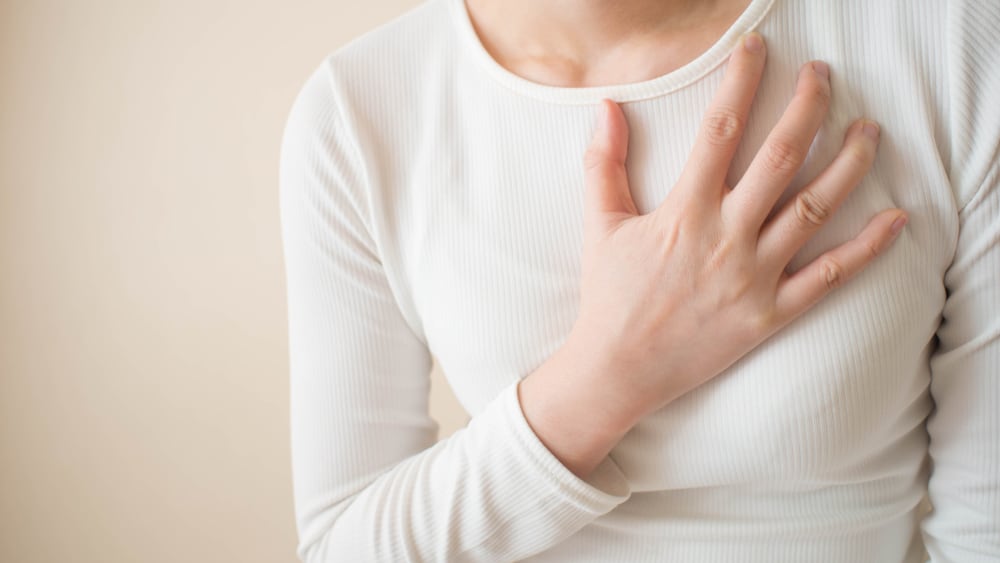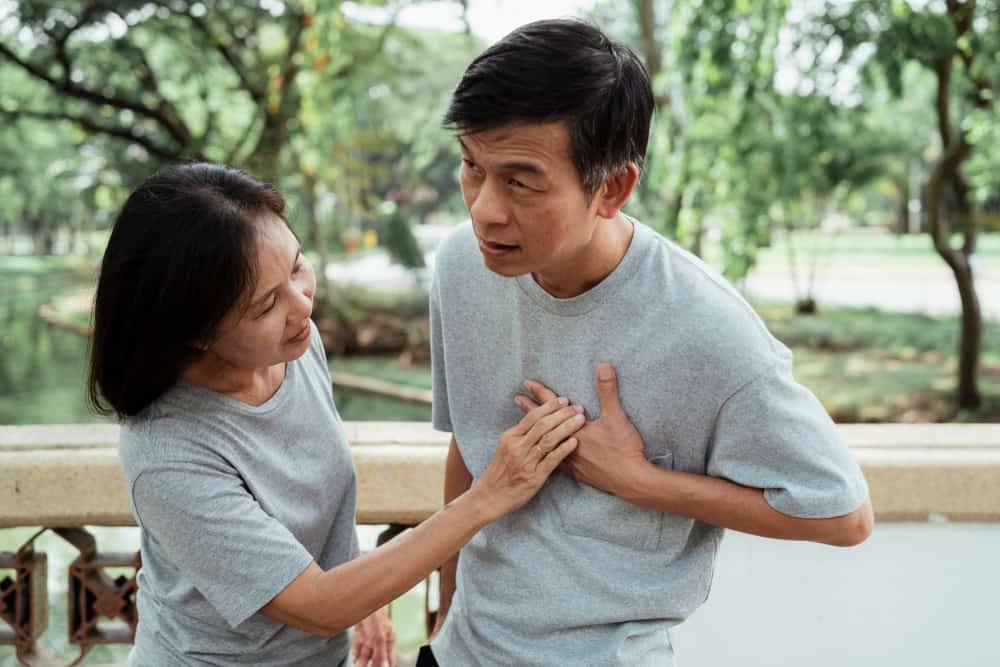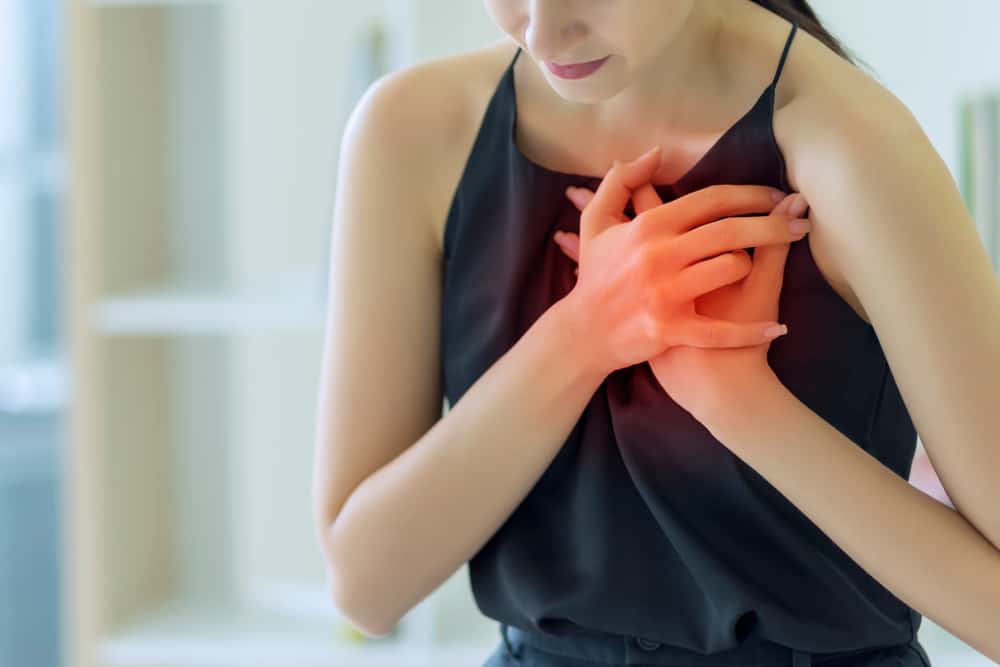Recognize the Causes of Chest Pain and How to Overcome it

Chest pain is a common complaint for many people. The condition may appear occasionally and not return. However, there are also those who feel it constantly and get worse. Actually, what causes chest pain? So, how are the symptoms and how to deal with them? Check out the full review below.
How is chest pain generally felt?

In simple terms, chest pain is pain that appears around the chest. The pain can be felt around the middle, left, or right chest. Chest pain causes different symptoms for each person and it also depends on the underlying cause.
The pain is described as a small needle prickling around the chest. Others may feel pressure, tightness and fullness, or a burning sensation in the chest. This pain can spread to the neck, jaw, lower back, and arms.
This condition lasts more than a few minutes, even hours. Sometimes it gets worse if you continue to do activities. It can also get better and disappear on its own or when you cease activities.
When the chest hurts, other symptoms that may accompany it include:
- Hard to breathe.
- The body sheds a lot of cold sweat.
- The head feels dizzy and the body becomes weak.
- Nausea in your stomach and you may experience vomiting.
- Sour taste in the mouth or food that has been swallowed back into the mouth.
- Difficulty swallowing food.
- The pain in the chest gets worse when you change your body position, take a breath, or when you cough.
If you experience the above symptoms, going to the doctor is the best course of action to treat them. Moreover, if this condition occurs due to serious health problems.
What causes chest pain?

Reporting from the Mayo Clinic page, the causes of pain in the chest are very diverse, including:
Heart disease
Chest pain on the left is a typical symptom of various heart diseases. Usually, other symptoms that indicate heart disease are shortness of breath or fainting. Problems, disorders, or diseases that affect the heart and cause pain in the chest are:
- Heart attack. This condition often results from blocked blood flow or a blood clot. Usually this condition occurs because of atherosclerosis or coronary heart disease.
- Angina. Angina is the term for chest pain caused by poor blood flow to the heart. Usually, this condition occurs due to plaque buildup on the inner walls of the arteries and narrows the arteries.
- Pericarditis. Pericarditis is inflammation of the sac that surrounds the heart (pericardium). The pain in the chest will get worse when you inhale or when you lie down.
- Aortic dissection. This condition is life-threatening because it involves the main artery in the heart (aorta), and can even cause the aorta to rupture.
Digestive problems
Chest pain can also be caused by digestive problems, such as:
- GERD. GERD causes stomach acid in the stomach to rise to reach the esophagus, causing heartburn (a burning sensation in the chest).
- Dysphagia (difficulty swallowing). This disruption in the esophagus can cause difficulty swallowing and chest pain.
- Problems with the gallbladder or pancreas. Gallstone disease or inflammation of the pancreas can cause abdominal pain that radiates to the chest.
It should be noted that the symptoms of chest pain, a sign of heartburn at first glance, are almost the same as a heart attack. However, you need to know that heartburn usually appears in the middle area of the chest and occurs after you eat and lie down.
Problems with muscles and bones
Apart from being related to digestion and the heart, chest pain can also arise due to problems with the muscles and bones, such as:
- Fibromyalgia. The condition fibromyalgia can cause chronic pain in the muscles around the chest that is persistent.
- Costochondritis. In this condition, the cartilage that connects the ribs to the sternum becomes inflamed, causing pain in the chest area.
Lung problems
Not only the heart, the lungs are also around the chest. If this vital organ is having problems, it is natural for your chest to cause pain. The following are various lung problems that commonly cause chest pain:
- Pulmonary embolism. Pulmonary embolism occurs when a blood clot lodges in the pulmonary artery, blocking blood flow to the lung tissue and causing chest pain.
- The lung collapses (collapses). This condition occurs due to air leaking into the space between the lungs and ribs. Chest pain, which is a typical symptom, will last for hours, followed by shortness of breath.
- Pleasure. This condition indicates inflammation of the membrane that lines the lungs, which can cause chest pain when coughing or inhaling.
- Pulmonary hypertension. People with pulmonary hypertension have high blood pressure in the arteries that carry blood to the lungs.
Other health problems
The appearance of pain in the chest can also be caused by the following conditions:
- Panic attack. When people with this condition experience fear, they usually experience chest pain followed by rapid breathing, nausea, and dizziness.
- Shingles. The disease, known as shingles or shingles, is caused by the reactivation of the chickenpox virus in the body, causing pain in the chest if there are skin blisters in the area.
Various effective ways to deal with chest pain

The causes are very diverse, making you have to undergo a series of medical tests. After the cause is identified, then doctors decide which treatment is right for chest pain.
Common medical tests include a physical exam, an electrocardiogram (EKG), blood tests, chest x-rays, and CT scans. The goal is to observe the electrical impulses of the heart, the condition of the lungs and digestive tract, and to ensure inflammation.
Furthermore, the ways to deal with chest pain that doctors usually recommend are:
Take chest pain relievers
The following types of drugs are usually prescribed by doctors to relieve chest pain, including:
- Medicines to relax the arteries, such as nitroglycerin. This medication is taken orally placed under the tongue to relax the heart arteries so that blood can flow more easily through narrow spaces. Some medications to lower blood pressure can also relax and widen blood vessels.
- Medicines to relieve chest pain associated with heart disease, such as aspirin.
- Thrombolytic drugs that are given to dissolve clots that are blocking blood from reaching the heart muscle. Usually this drug is given to people who experience chest pain due to heart attacks.
- Acid production suppressants in people who experience heartburn so that stomach acid in the stomach does not rise into the esophagus.
- Blood thinners are given to treat blood clots in the arteries, which can block blood flow to the heart and lungs. This drug is given to prevent the formation of new blood clots, an example of the drug is warfarin.
- Gastric acid suppressor drugs so that stomach acid does not excess and rise into the esophagus. This drug is usually prescribed for people with GERD.
- Antidepressants are given to people experiencing panic attacks to control chest pain as a symptom.
Surgical procedure
If the above treatments are not effective enough for chest pain, the doctor will recommend a medical procedure in the form of surgery. Usually this is done if the condition is severe enough and life-threatening if not treated immediately.
Advanced medical procedures to treat chest pain include:
- Angioplasty and heart stamping. If the pain in the chest is caused by a blockage in the artery of the heart, the doctor will insert a catheter with a balloon at the end into the blood vessel. The tip of the balloon will be inflated to widen the artery so that it is not narrow. In some cases, a stent (heart ring) will be placed to hold the narrowed artery wide.
- Heart bypass surgeryg. During this heart bypass procedure, the surgeon removes a blood vessel from another part of the body and uses it to create an alternative pathway for blood to flow around the blocked artery.
- Dissection repair. You may need emergency surgery to repair aortic dissection – a life-threatening condition in which an artery that carries blood from your heart to the rest of your body bursts.
- Lung reinflation. If you have a collapsed lung, your doctor may insert a tube into your chest to refill the lungs.
Before determining treatment, the doctor will observe the side effects and benefits of the type of treatment being carried out. This is done to minimize the disturbing side effects that will later occur.
Hello Health Group does not provide medical advice, diagnosis or treatment.
Chest pain – Symptoms and causes. (2017, December 8). Mayo Clinic. https://www.mayoclinic.org/diseases-conditions/chest-pain/symptoms-causes/syc-20370838 [Accessed on October 27th, 2021]
Chest pain: MedlinePlus medical encyclopedia. MedlinePlus – Health Information from the National Library of Medicine. https://medlineplus.gov/ency/article/003079.htm [Accessed on October 27th, 2021]
Chest pain. (2017, October 18). nhs.uk. https://www.nhs.uk/conditions/chest-pain/ [Accessed on October 27th, 2021]
Angina (Chest pain). www.heart.org. https://www.heart.org/en/health-topics/heart-attack/angina-chest-pain [Accessed on October 27th, 2021]
Harvard Health Publishing. (2020, September 16). Chest pain: A heart attack or something else? Harvard Health. https://www.health.harvard.edu/heart-health/chest-pain-a-heart-attack-or-something-else [Accessed on October 27th, 2021]
Heartburn or heart attack: When to worry. (2017, June 7). Mayo Clinic. https://www.mayoclinic.org/diseases-conditions/heartburn/in-depth/heartburn-gerd/art-20046483 [Accessed on October 27th, 2021]